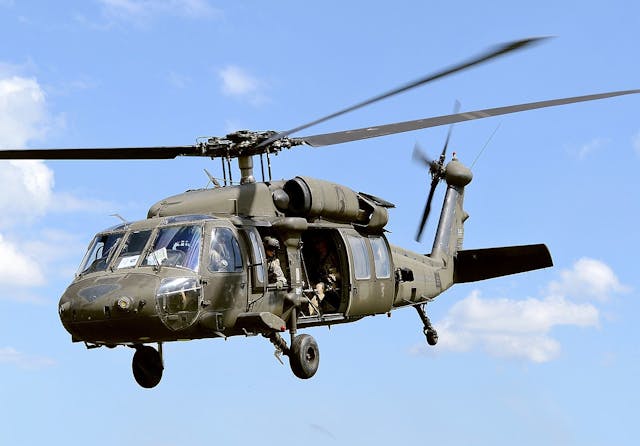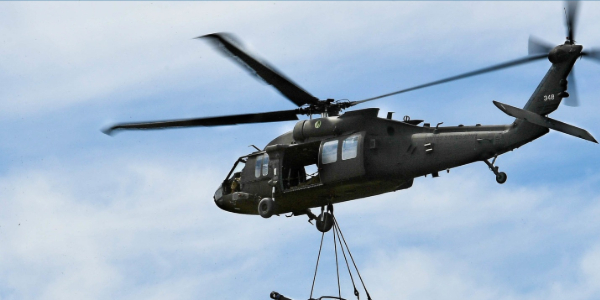Introducing the Power and Versatility of the Blackhawk Helicopter
The Blackhawk helicopter stands as a testimony to engineering quality and armed forces innovation, substantially forming the landscape of modern-day airborne procedures. Initially established in the late 1960s, this dual-engine aircraft has advanced right into a complex platform efficient in performing an array of objectives, from tactical troop releases to immediate clinical evacuations. Its style integrates cutting-edge innovation and products, enhancing both performance and survivability. As we discover its background and functional abilities, one should take into consideration how the Blackhawk remains to influence modern fight approaches and humanitarian efforts alike. What does this mean for the future of armed forces aviation?
History of the Blackhawk
The history of the Blackhawk helicopter is noted by significant technical improvements and a tactical evolution in army air travel. Developed in the late 1960s by Sikorsky Aircraft, the UH-60 Blackhawk was initially conceived to change the older UH-1 Iroquois, generally called the "Huey." The Blackhawk's initial flight happened in 1974, and it was officially presented to the U.S. Military in 1979.


This airplane was developed to meet the requiring needs of modern-day war, concentrating on versatility, toughness, and speed (Blackhawk Helicopter). Its capability to run in different atmospheres, paired with sophisticated avionics and layout features, swiftly established the Blackhawk as an important property for army procedures worldwide
Throughout the 1980s and 1990s, the Blackhawk saw extensive usage in various problems, including the Gulf Battle and altruistic goals. The helicopter's adaptability permitted it to offer multiple functions, from army transport to medevac and logistical assistance. As innovation advanced, so did the Blackhawk, bring about many versions that dealt with details mission requirements. Today, the Blackhawk stays an iconic icon of military air travel, constantly improved to satisfy contemporary obstacles.
Trick Attributes and Specifications
Blackhawk helicopters are renowned for their design quality and functional versatility, flaunting a range of vital attributes and requirements that enhance their effectiveness in different military functions. Among the most significant features is their dual-engine arrangement, usually powered by the T700-GE-701C engines, which offer phenomenal dependability and efficiency. The helicopter has an optimum cruise rate of around 150 knots and a solution ceiling of approximately 20,000 feet, allowing it to operate effectively in varied settings.
The Blackhawk's airframe is built from advanced composite materials and light weight aluminum alloys, making certain a durable framework while decreasing weight. It includes a totally articulated blades system that supplies superior dexterity and stability. The helicopter can accommodate approximately 11 battle soldiers or carry up to 8,000 pounds of exterior freight, making it extremely versatile for different objectives.
Furthermore, the Blackhawk is geared up with advanced avionics and interaction systems, enhancing situational recognition and objective coordination. Its ability to run in adverse climate condition, integrated with its low acoustic signature, makes it a sneaky option for tactical procedures. On the whole, these features add to the Blackhawk's online reputation as a cornerstone of modern armed forces aeronautics.
Versatile Operational Roles
Distinguished for their engineering excellence and advanced capacities, Blackhawk helicopters serve a wide range of functional duties within military structures. Initially created for army transportation, their convenience has actually broadened, enabling them to do various objectives effectively.
One of the main functions of the Blackhawk is as an utility helicopter, promoting logistical support by delivering employees and supplies to and from remote places. In addition, they master medical evacuation (MEDEVAC) procedures, furnished with innovative medical devices and personnel to offer essential care in the area.
In combat situations, Blackhawks can run as armed escort systems, you can find out more supporting ground forces by engaging enemy assets while making sure army safety. Their ability for unique operations makes them essential; they can conduct reconnaissance objectives, employees healing, and direct activity raids, typically in high-threat settings.
Furthermore, the Blackhawk's adaptability enables it to sustain humanitarian objectives and catastrophe response efforts, supplying help and necessary solutions in times of situation. This wide range of operational duties shows the Blackhawk helicopter's unparalleled convenience, declaring its standing as a crucial possession in contemporary army operations worldwide.
Technical Advancements
Numerous technological technologies contribute to the Blackhawk helicopter's extraordinary performance and flexibility in varied operational settings. Among one of the most substantial developments is its composite rotor blades, which enhance lift and maneuverability while lowering weight and upkeep requirements. The rotor system uses sophisticated materials that boost longevity and withstand ecological deterioration, guaranteeing dependable operation in extreme conditions.
Furthermore, the Blackhawk is equipped with a state-of-the-art avionics suite that incorporates innovative navigation and interaction systems - Blackhawk Helicopter. This consists of GPS, radar, and multi-function screens that promote real-time situational understanding for pilots, adding to mission success under tough situations
Furthermore, the helicopter's fly-by-wire control system permits precise handling and boosted responsiveness, giving pilots with improved control throughout facility maneuvers. The unification of advanced engine technology, such as the T700-GE-701C engine, additional enhances performance, supplying enhanced power outcome and gas efficiency.
Finally, modular design principles make it possible for quick reconfiguration for various objectives, from troop transportation to medical evacuation, making the Blackhawk a flexible property in armed forces and humanitarian procedures. These technological technologies jointly ensure that the Blackhawk stays a formidable visibility in the skies.
Influence on Modern War

Equipped with innovative avionics and interaction systems, the Blackhawk enables seamless sychronisation amongst ground and air units, making sure exact and prompt response to dynamic fight situations. Its versatility enables for rapid release in diverse atmospheres, from city setups to sturdy surfaces, showing the complex nature of modern warfare.
Additionally, the Blackhawk's premium rate and dexterity promote fast insertion and removal of personnel, reducing direct exposure to adversary fire. Its capability to operate in hostile conditions, matched with sophisticated protective actions, improves survivability and goal success rates.
As modern disputes he said significantly depend on joint operations and fast reaction, the Blackhawk helicopter remains at the forefront of military approach, symbolizing the development of air wheelchair and the important duty of air power in accomplishing tactical goals. Its effect on modern-day go to the website war remains to redefine the abilities of militaries globally.

Final Thought
To conclude, the Blackhawk helicopter exemplifies the crossway of sophisticated design and functional flexibility, strengthening its standing as a cornerstone of contemporary army aeronautics. Its historical importance, exceptional attributes, and adaptability across various objective accounts emphasize its crucial function in contemporary war. As technical technologies remain to improve its capacities, the Blackhawk continues to be an important possession for armed forces around the world, demonstrating unrivaled efficiency in both battle and humanitarian operations.
The Blackhawk helicopter stands as a testament to design quality and armed forces innovation, considerably forming the landscape of modern aerial operations.The history of the Blackhawk helicopter is marked by significant technical innovations and a critical advancement in armed forces air travel.Blackhawk helicopters are renowned for their engineering excellence and operational flexibility, flaunting a range of vital attributes and requirements that boost their efficiency in various army roles.Numerous technical developments add to the Blackhawk helicopter's exceptional efficiency and adaptability in varied functional atmospheres.In verdict, the Blackhawk helicopter exemplifies the junction of advanced design and operational convenience, solidifying its standing as a foundation of modern-day armed forces aviation.